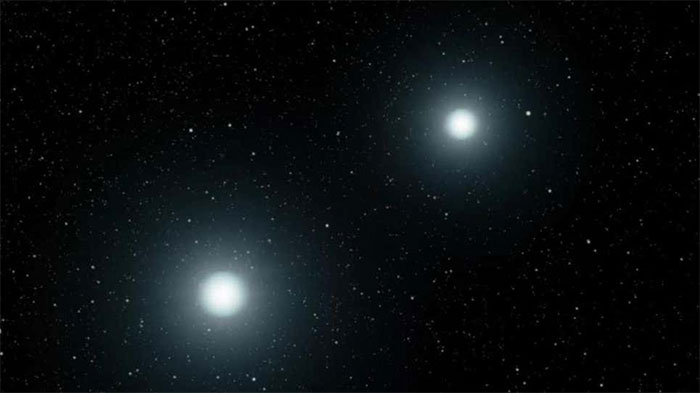Research sheds light on white dwarf stars capable of destroying the Solar System
A new study by international scientists has shed light on white dwarfs that have the ability to destroy the Solar System .
According to an April 9 article in the journal of the British Royal Astronomical Society (MNRAS), scientists at the University of Warwick (UK) and many other universities have studied the impact of white dwarfs - these stars in a state where they have burned all their fuel - for planetary systems like the Solar System.
Previous studies have shown that when asteroids, moons and planets approach white dwarfs, the enormous gravity of these dense stars rips the small planets into pieces. the smaller. These pieces continue to collide and are eventually ground into dust.

Two white dwarf stars in the process of stellar merger. (Illustration photo: NASA)
New research suggests that the "killer" white dwarf star that could "kill" Earth is already part of our Solar System. When the Sun "dies" and turns into a white dwarf star, it can "swallow" or "tear apart" the Earth. The rest of our Solar System, including the asteroids between Mars and Jupiter, as well as Jupiter's moons, could eventually suffer the same fate when the Sun turns into a star. white dwarf. However, even if Earth outlived the Sun, our planet would no longer be suitable for life.
To learn about what might happen to asteroids, moons and planets approaching white dwarfs, the team of researchers investigated changes in the stars' brightness over 17 years, focusing on 3 white dwarf stars with different "behavior" including ZTF J0328-1219, ZTF J0923+4236 and WD 1145+017 . What they discovered is that the fate of objects can be extremely dire when approaching dwarf stars.
They came to this conclusion after analyzing the "fluctuations" of asteroids, Moons and planets - the decrease in the brightness of stars caused by objects passing in front of them. Unlike the predictable "fluctuations" caused by planets orbiting stars, "fluctuations" caused by debris are strangely shaped, chaotic, and disorderly.
Professor Boris Gaensicke at the University of Warwick said it was a simple but surprising fact that it was possible to detect fragments of asteroids, which could be the Moon or even planets orbiting a dwarf star. every few hours, but his and his colleagues' research shows that this process of movement and collision can develop rapidly in just a few years. According to Professor Gaensicke, even though he and his colleagues think they are researching in the right direction, the fate of these systems is much more complicated than they can imagine.
Research leader Dr. Amornrat Aungwerojwit at Naresuan University in Thailand said the process and results of the above collisions provide a basis to help researchers determine the type of material that creates planets. initial.
- Strange planet death story helps bring life
- Death star bends light
- See before the end of the earth
- How long does it take to get up to 7 life-capable planets - has Trappist-1 been discovered?
- Detecting strange stars invades the solar system
- The 9th planet can cause disaster for the solar system
- Revealing a new dwarf planet right in the Solar System
- Stunned to discover a new dwarf planet in the Solar System
- Discover new dwarf planets in the Solar System
- Unusual white dwarf discovery: Formed by collision between two other white dwarfs
- How will the sun of the solar system die?
- A white dwarf will explode in the next few million years
 Van Allen's belt and evidence that the Apollo 11 mission to the Moon was myth
Van Allen's belt and evidence that the Apollo 11 mission to the Moon was myth The levels of civilization in the universe (Kardashev scale)
The levels of civilization in the universe (Kardashev scale) Today Mars, the sun and the Earth are aligned
Today Mars, the sun and the Earth are aligned The Amazon owner announced a secret plan to build a space base for thousands of people
The Amazon owner announced a secret plan to build a space base for thousands of people